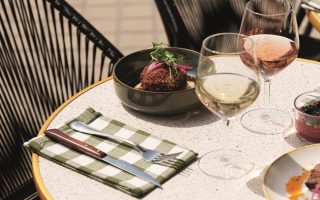The World’s Most Expensive Rosé

Patrice Bertrand meets a winemaker creating rosés in Languedoc that have been voted the best in the world.
“I remember the first time I opened this estate’s gate,” says Gérard Bertrand in his sing-song southwest French accent. “I was immediately moved by the place’s magic, beauty and unique schist and limestone terroir. I had a vision: to create the greatest rosé in the world.”
This unique place, where vineyards extend forever on hillsides covered with oaks and olive trees, is Domaine du Clos du Temple, in Cabrières, in the Hérault department. Bertrand, a former rugby player who is one of the most prominent winegrowers in Languedoc (he owns 15 other wine estates), bought Domaine du Clos du Temple in 2017 with the goal of putting rosé wines on a par with the finest reds and whites.
He realised his dream: in 2020, his second Cabrières vintage, Clos du Temple 2019, was voted best rosé in the world by Drinks Business Global Rosé Masters, the biggest international rosé competition. It beat Garrus from Sacha Lichine’s Château d’Esclans, a Côtes-de- Provence considered one of the world’s finest rosés. Clos du Temple holds another record: at €190 a bottle, it’s the most expensive rosé in the world, a position Garrus held since 2006 (€110).

Winemaker Gérard Bertrand © Ulrich Lebeuf
“My Fire, My Blood, My Sun”
It’s no coincidence that the charismatic Bertrand, originally from Narbonne, chose to make rosé in Cabrières, an hour from Montpellier. During the 14th century, the village and its picturesque five valleys were famous for vin vermeil, a uniquely vermillion-coloured wine, one of King Louis XIV’s favourites. The poet Saint-Amant even sang of its virtues in verse: “Give me some of this vermeil wine… It is my fire, my blood, my sun.”
Today, this area is home to the vineyards of the tiny PDO Languedoc-Cabrières, known for reds and rosés – the vermeil colour has given way to the trendier pale robes. Bertrand’s Clos du Temple, made to be kept for years, is a blend of Cinsault, Grenache, Syrah, Mourvèdre and Viognier grapes which are biodynamically grown, using donkeys rather than machines.

Rosés made by Sacha Lichine at Château d’Esclans are considered some of the world’s best © David Atlan
Spiritual Impetus
Above all, Bertrand is convinced that the place is sacred. After buying the estate, he built an ultra-modern cellar in the middle of 12 hectares of vineyards, costing €6m. Semi-underground with spectacular views of the valley, the ‘Temple’ is equipped with huge pyramidal bauxite vats. “These vats symbolise the link between the terrestrial and the celestial,” he says. “This unique environment creates alchemy and spiritual impetus.”
So far, Bertrand has produced three vintages in Cabrières. The first was presented in 2019 at three-star Michelin restaurant Guy Savoy in Paris, and more will follow. Naturally, one wonders if these gastronomic rosés, available online or at Château l’Hospitalet, Bertrand’s seaside vineyard/spa resort near Narbonne, are worth their price. That’s a matter for experts, but one thing is certain: this wine deserves credit for spotlighting the Languedoc-Cabrières appellation, the smallest in Languedoc. “By marketing this extraordinarily expensive wine, Bertrand has helped increase our notoriety,” observes Luc Flache, director of Estebel, the Cabrières winegrowers’ cooperative.
Good news – there, you’ll find rather more affordable rosés: from €5.50 to €10.50 a bottle.
Gérard Bertrand: www.gerard-bertrand.com
Cave de l’Estabel: www.estabel.fr
From France Today magazine
Lead photo credit : Domaine du Clos du Temple in Cabrières © Gilles Deschamps
Share to: Facebook Twitter LinkedIn Email
More in French cuisine, French food, French wine, rose wine, vineyards, vintage
Leave a reply
Your email address will not be published. Required fields are marked *



